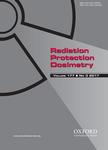版权所有:内蒙古大学图书馆 技术提供:维普资讯• 智图
内蒙古自治区呼和浩特市赛罕区大学西街235号 邮编: 010021

作者机构:Deutsch Krebsforschungszentrum Abt Med Phys Radiol E020 D-69120 Heidelberg Germany Siemens Med Solut D-91052 Erlangen Germany
出 版 物:《RADIATION PROTECTION DOSIMETRY》 (辐射防护剂量学)
年 卷 期:2005年第117卷第1-3期
页 面:74-78页
核心收录:
学科分类:0830[工学-环境科学与工程(可授工学、理学、农学学位)] 1004[医学-公共卫生与预防医学(可授医学、理学学位)] 08[工学] 0827[工学-核科学与技术] 1009[医学-特种医学]
主 题:RF field Histology Image X-ray imaging Scanner Computer hardware Guidance placement of stent target organ soft parts three-dimensional displays limited access Catheters Frame Rate image samples
摘 要:At present, interventional procedures, such as stent placement, are performed under X-ray image guidance. Unfortunately with X-ray imaging, both patient and interventionalist are exposed to ionising radiation. Furthermore, X-ray imaging is lacking soft tissue contrast and is not capable of true 3-D displays of either interventional device or tissue morphology. Magnetic resonance imaging (MRI) offers excellent soft tissue contrast, 3-D acquisition techniques, as well as rapid image acquisition and reconstruction. Despite these advantages, MR-guided interventions are challenging owing to the limited access to the patient, strong magnetic and radio-frequency fields that require special interventional devices, inferior image frame rates and spatial resolution, and high MRI scanner noise. For MR-guided intravascular interventions, where access to the target organ is achieved through catheters, dedicated hardware and automated image slice positioning techniques have been developed. We illustrate that MR-guided renal embolisations can be performed in closed-bore high-field MR scanners.